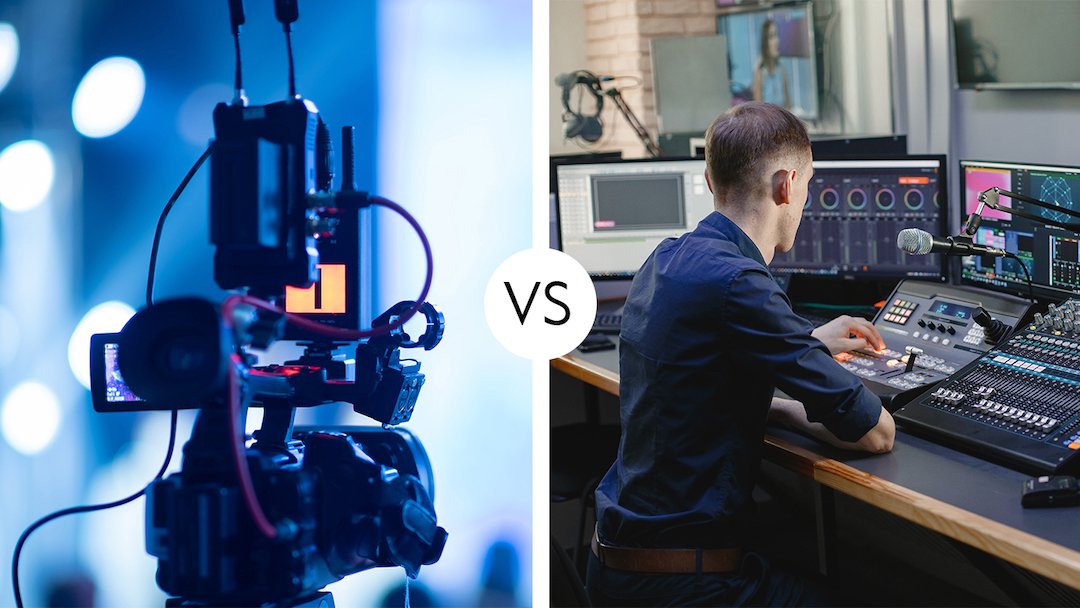
In today’s digital age, effective communication and messaging play a crucial role in the success of any organization. In order to deliver your message to your target audience, you need to utilize appropriate tools and platforms. There will always be a need for effective communication and messaging within a business. Getting this message across to your audience requires certain tools. These tools are usually classified under one of two modes of communication — Broadcasting or Streaming. Each mode of communication comes with its own set of perks and drawbacks that could have a major effect on the message itself. Let’s take a deeper look into the differences between broadcasting and streaming, and figure out which solution works best for your organization.
What is Broadcasting?
Broadcasting refers to the distribution of audio and video content over traditional networks such as television and radio. The content is transmitted from a singular source to multiple receiving devices simultaneously. Broadcasting has been one of the most popular forms of media consumption over the last century due to its reach.
Advantages of Broadcasting
Extensive Reach: Broadcasting has the potential to reach a wider audience compared to online streaming. Traditional receiving devices like TVs and radios are readily available to a larger population, making it easier to disseminate information to a broader demographic.
Credibility and Authority: Broadcasting platforms, such as television networks and radio stations, often have established credibility and authority. Being featured on these platforms can enhance the perceived reliability and prestige of your content.
Scheduled Delivery: Broadcasting allows content to be delivered at specific times, ensuring that the message reaches the audience as intended. It is not reliant on internet speeds and capabilities, making it suitable for time-sensitive events and programming.
Limitations of Broadcasting
Limited Interactivity: Broadcasting is predominantly a one-way mode of communication, lacking significant viewer engagement. While viewers can consume the content, their ability to interact or provide feedback is limited.
Cost and Infrastructure: Broadcasting typically requires substantial investment in equipment and infrastructure, such as satellites and radio towers. Establishing a broadcasting network can be financially demanding and may require regulatory approvals.
What is Streaming?
Streaming, on the other hand, refers to the delivery of audio and video content over the internet in real time. Rather than being broadcasted from a central source to multiple receiving devices, streaming sends the content directly from the server to each individual user’s device, be it a television, computer, smartphone, or tablet. The user can then view the content as it arrives, without having to wait for the entire file.
Advantages of Streaming
Interactivity and Engagement: Streaming offers a higher level of interactivity and engagement compared to broadcasting. Users can interact with the content in real time through features like chat rooms, comments, and live polls, fostering a sense of community and active participation.
Targeted Delivery: Streaming platforms allow for more precise targeting of content based on specific interests and demographics of the audience. This enables organizations to tailor their messaging and offerings to a particular niche or subset of viewers.
Cost-Effectiveness: Streaming can be a more cost-effective solution compared to broadcasting, particularly in terms of infrastructure. It leverages existing internet infrastructure and does not require substantial upfront investments in satellites or radio towers.
Limitations of Streaming
Accessible Technology: While internet connectivity is increasingly widespread, streaming still relies on users having access to the necessary technology and stable internet connections. This may limit the potential audience size compared to traditional broadcasting.
Bandwidth Dependency: Streaming quality and performance can be affected by fluctuations in internet bandwidth. Low bandwidth or connectivity issues can result in buffering or poor viewing experiences for users.
Differences in Usage of Streaming and Broadcasting
Both streaming and broadcasting can be the right method for sharing content depending on the specific goal and target:
Broadcasting: Television and radio shows, news broadcasts, live sporting events, and other large-scale events are typically broadcasted over traditional networks. The idea behind this is the large and diverse audience that these events attract. National and worldwide audiences are best reached through traditional media (broadcasting).
Streaming: Corporate webinars, live product demos, remote training sessions, and live-streamed events are just a few examples of events that are often streamed over the internet. This allows for more specifically targeted sharing of content.
Broadcasting vs. Streaming — Key Benefits
Broadcasting: Broadcasting offers a more diverse reach and a higher level of credibility since the content is broadcasted over a large scale. Broadcasting can ensure that content is delivered at the right time, as it is not reliant on internet speeds and capabilities.
Streaming: Streaming offers a higher level of flexibility, as content can be accessed from anywhere, making it ideal for remote training sessions, corporate webinars, and other events that require accessibility from multiple locations. Streaming also offers a lower cost of entry, as it requires less equipment and infrastructure compared to broadcasting.
Exploring Opportunities: Streaming vs. Broadcasting Solutions
Flexibility in Content Creation: Streaming platforms often provide greater flexibility in terms of content creation. Unlike broadcasting, which often follows strict schedules and programming formats, streaming allows organizations to experiment with different content formats, durations, and styles. This flexibility can be beneficial for creating interactive and engaging experiences tailored to specific target audiences.
On-Demand Viewing: One of the significant advantages of streaming is the ability to offer on-demand viewing. Viewers can access recorded content at their convenience, allowing them to watch or rewatch content whenever they prefer. This feature is particularly useful for training materials, educational content, and conferences where attendees may have conflicting schedules.
Analytics and Insights: Streaming platforms offer robust analytics and insights into viewer behavior and engagement. Organizations can gather data on viewership, watch duration, interaction levels, and demographic information. These insights enable businesses to refine their content strategy, understand their audience better, and make data-driven decisions for future broadcasts or streams.
Monetization Opportunities: Streaming platforms often provide various monetization options for content creators. Organizations can generate revenue through advertising, sponsorships, pay-per-view models, or subscription-based access to premium content. This monetization potential can be appealing for businesses looking to generate income from their content offerings.
Global Accessibility: While broadcasting can reach a wide audience, streaming opens up opportunities for global accessibility. With the internet being accessible worldwide, streaming allows organizations to reach viewers beyond their local or national boundaries. This can be advantageous for businesses targeting international markets or wanting to expand their reach beyond traditional broadcasting limitations.
Interactivity for Remote Collaboration: Streaming solutions often incorporate features that facilitate remote collaboration and communication. Businesses can conduct interactive webinars, virtual meetings, or training sessions, where participants can ask questions, provide feedback, and engage in real-time discussions. This interactivity fosters a sense of connection and enables effective remote collaboration.
Enhanced Engagement through Social Media Integration: Streaming platforms can seamlessly integrate with social media platforms, enabling viewers to share, comment, and engage with the content across various social channels. This integration amplifies the reach of the content, encourages social sharing, and allows for real-time conversations around the streamed content.
Adaptability to Mobile Devices: With the proliferation of smartphones and tablets, streaming content on mobile devices has become increasingly popular. Streaming solutions are designed to be mobile-friendly, ensuring that users can access and view content on the go. This adaptability to mobile devices expands the potential audience and makes content consumption more convenient for users.
Niche and Specialized Content: Streaming platforms provide opportunities for organizations to cater to specific niche or specialized audiences. Whether it’s a dedicated channel for a particular industry, hobby, or interest, streaming allows businesses to create content that appeals to specific communities or demographics, fostering a sense of connection and loyalty among the audience.
Hybrid Solutions: In some cases, a combination of broadcasting and streaming may be the most effective approach. Hybrid solutions leverage the strengths of both modes of communication. Organizations can broadcast major events or announcements while simultaneously offering live streaming options and interactive features to engage a broader audience and facilitate real-time interactions.
Making the Right Choice: Factors to Consider in Selecting the Ideal Communication Platform
Choosing between broadcasting and streaming solutions requires a thorough understanding of your organization’s goals, resources, and audience. Broadcasting provides a wider reach and a high level of credibility, making it ideal for large-scale events like news.
Alternatively, streaming offers higher engagement, flexibility, and cost-effectiveness, making it ideal for corporate webinars, remote training sessions, and live-streamed events. In the end, the decision between the two will depend on how you choose to reach your target audience. Making the right decision in this scenario will guarantee effective communication with your intended audience, delivering the content they require in the manner they prefer.
Harvey is an award-winning director and writer, known for writing many bios including this one and the one on his Instagram account. In 2022 he shot his latest short film Are We Doing This? which is currently in crowdfunding on Indiegogo. He has directed several other shorts including The Many Faces of Beth Jones, Yes, Virginia, and the award-winning Life’s a Show.
If he’s not busy making films or feeling uncomfortable writing a biography in the third person, you’ll find him at Raindance as the Filmmaker in Residence.














